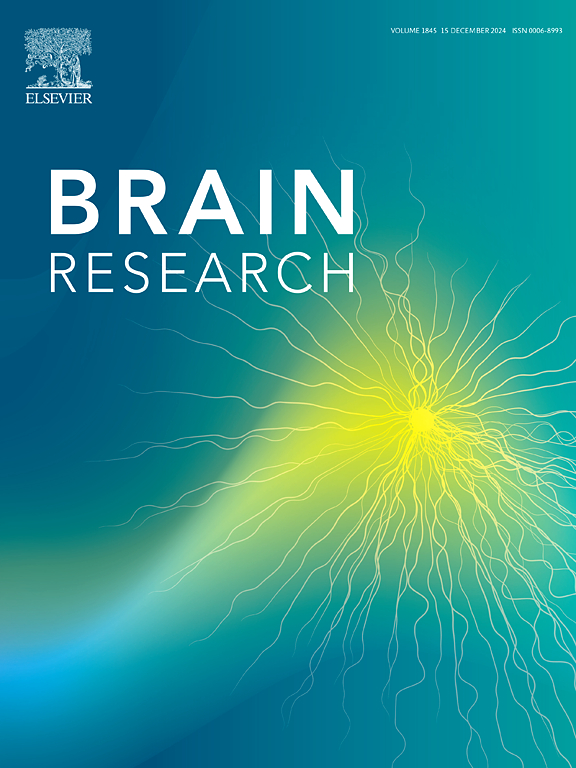Association between Electroencephalographic microstates abnormalities and cognitive dysfunction in drug-naive MDD
IF 2.7
4区 医学
Q3 NEUROSCIENCES
引用次数: 0
Abstract
Objectives
This study aims to investigate the link between Electroencephalography (EEG) microstate anomalies and cognitive impairments in individuals with drug-naive Major depressive disorder (MDD).
Methods
We recruited 29 patients with drug-naive MDD and 30 healthy controls. The Hamilton Depression Rating Scale (HDRS-17) measured symptom severity, the MATRICS Consensus Cognitive Battery (MCCB) assessed neurocognitive function, and resting-state EEG data were collected using 64 scalp electrodes. Analysis of EEG microstates was conducted via the Microstate Analysis plugin for EEGLAB.
Results
MDD group had lower scores in six neurocognitive MCCB domains. For EEG microstates, four similar ones (A − D) were found in both groups. Notably, microstate C duration was lower in MDD group (t = 4.549, P < 0.001), microstate D occurrence (t = 2.258, P = 0.028) and proportion (t = 3.733, P < 0.001) were lower in MDD group. There were significant differences in all 4 microstate transition probabilities between groups. For example, A − B, B − A etc. transitions were higher in MDD, while A − C, A − D etc. were lower. The proportion of microstate D was found positively correlated with Speed of processing (SOP) score (r = 0.499, df = 26, P = 0.007) and Working memory (WM) score (r = 0.451, df = 26, P = 0.016). The Occurrence of microstate D was found positively correlated with SOP score (r = 0.383, df = 26, P = 0.044) and WM score (r = 0.389, df = 26, P = 0.041).
Conclusions
MDD patients show alterations in sub-second brain dynamics, characterized by a decreased proportion and occurrence of microstate D and shorter duration of microstate C, and significant shifts in microstate transition probabilities. These changes correlate with cognitive deficits across several domains, including processing speed and working memory.
脑电微观状态异常与认知功能障碍在药物幼稚型重度抑郁症之间的关系
目的探讨药物型重度抑郁障碍(MDD)患者脑电图(EEG)微状态异常与认知障碍之间的关系。方法招募29例初治MDD患者和30例健康对照。汉密尔顿抑郁评定量表(HDRS-17)测量症状严重程度,matrix共识认知电池(MCCB)评估神经认知功能,并使用64个头皮电极收集静息状态脑电图数据。通过EEGLAB微状态分析插件进行脑电微状态分析。结果smdd组在6个神经认知MCCB域得分较低。在脑电微态方面,两组均有4个相似的微态(A ~ D)。值得注意的是,MDD组微状态C持续时间较短(t = 4.549, P <;0.001)、微态D发生率(t = 2.258, P = 0.028)和比例(t = 3.733, P <;0.001), MDD组较低。4种微观状态转移概率组间差异均有统计学意义。例如,在MDD中,A−B、B−A等转换较高,而A−C、A−D等转换较低。微状态D的比例与加工速度(SOP)得分(r = 0.499, df = 26, P = 0.007)和工作记忆(WM)得分(r = 0.451, df = 26, P = 0.016)呈正相关。微状态D的发生与SOP评分(r = 0.383, df = 26, P = 0.044)和WM评分(r = 0.389, df = 26, P = 0.041)呈正相关。结论smdd患者亚秒脑动力学发生改变,表现为微状态D的比例和发生率下降,微状态C持续时间缩短,微状态转换概率发生显著变化。这些变化与多个领域的认知缺陷有关,包括处理速度和工作记忆。
本文章由计算机程序翻译,如有差异,请以英文原文为准。
求助全文
约1分钟内获得全文
求助全文
来源期刊

Brain Research
医学-神经科学
CiteScore
5.90
自引率
3.40%
发文量
268
审稿时长
47 days
期刊介绍:
An international multidisciplinary journal devoted to fundamental research in the brain sciences.
Brain Research publishes papers reporting interdisciplinary investigations of nervous system structure and function that are of general interest to the international community of neuroscientists. As is evident from the journals name, its scope is broad, ranging from cellular and molecular studies through systems neuroscience, cognition and disease. Invited reviews are also published; suggestions for and inquiries about potential reviews are welcomed.
With the appearance of the final issue of the 2011 subscription, Vol. 67/1-2 (24 June 2011), Brain Research Reviews has ceased publication as a distinct journal separate from Brain Research. Review articles accepted for Brain Research are now published in that journal.
 求助内容:
求助内容: 应助结果提醒方式:
应助结果提醒方式:


